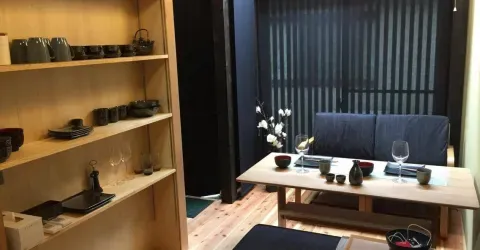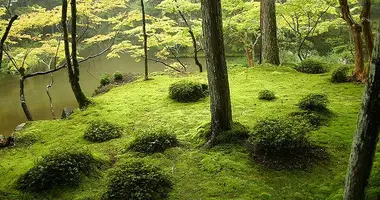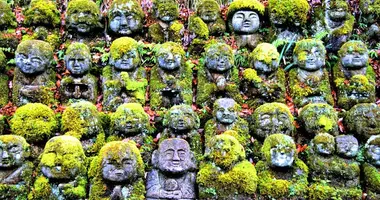Ninnaji Temple: A historic gem in Kyoto's cultural landscape

Ninnaji Temple, Main Gate, Japan
Nestled in the western outskirts of Kyoto, Ninnaji Temple stands as a testament to Japan's rich cultural heritage and imperial history. Founded in 888 CE by Emperor Uda, this World Heritage Site has captivated visitors for centuries with its serene beauty, traditional architecture, and profound religious significance. As the head temple of the Omuro School of Shingon Buddhism, Ninnaji offers a unique glimpse into the intertwining of imperial power and Buddhist practice. From its stunning five-story pagoda to its famous late-blooming cherry blossoms, Ninnaji Temple invites visitors to step back in time and immerse themselves in the cultural richness of ancient Kyoto.
History and significance of Ninnaji Temple
Ninnaji Temple's illustrious history dates back to the Heian period, when it was established by Emperor Uda in 888 CE. Originally serving as a summer villa for the Imperial Family, known as Omuro Palace, the site was transformed into a temple complex of great importance. After abdicating the throne, Emperor Uda became the first Monzeki, or aristocratic priest, of Ninnaji. This began a tradition that lasted until the end of the Edo Period, with members of the imperial family serving as head priests.
The temple's close connection to the imperial family elevated its status beyond that of a mere religious site. As a Monzeki temple, Ninnaji became a symbol of the fusion between imperial authority and Buddhist practice. This unique heritage has made it an enduring cornerstone of Kyoto's cultural landscape and a living museum of Japanese architectural evolution.
Throughout its history, Ninnaji has faced numerous challenges. In 1467, the temple was destroyed by fire and fighting during the Ōnin War. However, it was rebuilt approximately 150 years later with the help of Tokugawa Iemitsu, the third shogun of the Tokugawa shogunate. This reconstruction coincided with the rebuilding of the Imperial Palace in Kyoto, further cementing Ninnaji's imperial connections.
Architecture and notable buildings
Ninnaji Temple boasts an impressive array of architectural marvels, many of which date back to the 17th century reconstruction. The temple complex is home to several Important Cultural Properties and even a National Treasure. At the entrance stands the imposing Niomon gate, guarded by two fierce Nio statues. This gate, along with the Sanmon Gates at Nanzenji and Chion-in Temples, is considered one of the three most important gates in Kyoto.
The temple's crowning glory is undoubtedly its five-story pagoda, a stunning example of traditional Japanese architecture. Standing at 36 meters tall, the pagoda was built in 1637 and offers a picturesque backdrop to the temple grounds. While not open to the public, it remains an impressive sight from various vantage points within the complex.
Other notable structures include:
- The Kondō (Golden Hall): A National Treasure housing an image of Amitabha Buddha
- The Mieidō: An Important Cultural Property
- The Kyōzō (Sutra Repository): Housing sacred Buddhist texts
- The Shōrō (Bell Tower)
- The Kannon-dō: Dedicated to the Goddess of Mercy
Each of these buildings showcases the exquisite craftsmanship and architectural styles of their respective periods, offering visitors a tangible connection to Japan's rich cultural past.

Ninnaji Temple Guardian (Nio)

Buddhist statue in the grounds of the temple
The Goten: Former imperial residence and gardens
The highlight of a visit to Ninnaji is undoubtedly the Goten, the former residence of the head priest located in the southwestern corner of the temple complex. Built in the style of an imperial palace, the Goten offers a rare glimpse into the luxurious lifestyle of Kyoto's aristocracy during the Heian period.
The Goten complex consists of several interconnected buildings, including:
- The Shinden (main hall)
- The Kuro Shoin (Black Study)
- The Shiro Shoin (White Study)
These elegant structures are connected by covered walkways and feature beautifully painted fusuma sliding doors. The Kuro Shoin, in particular, boasts fusuma painted by the renowned artist Insho Domoto.
Surrounding the Goten are two exquisite gardens that further enhance its beauty:
- The South Garden (Nantei): A dry landscape garden reminiscent of the Kyoto Imperial Palace
- The North Garden (Hokutei): A pond garden featuring miniature mountains and a waterfall
These gardens not only serve as peaceful retreats but also as living examples of traditional Japanese landscape design. The interplay between the architectural elements and the natural surroundings creates a harmonious atmosphere that transports visitors to a bygone era of imperial splendor.

Cherry blossoms and the Omuro Cherries
Ninnaji Temple is renowned for its spectacular display of cherry blossoms, particularly the famous Omuro cherry trees. These unique late-blooming varieties, also known as Omuro zakura, are a hallmark of the temple and a beloved symbol of Kyoto's spring season.
The Omuro cherries are distinguished by their compact size, growing only to a height of about 2-3 meters. This low stature allows visitors to appreciate the blossoms up close, creating a more intimate viewing experience. The temple grounds boast approximately 200 of these trees, primarily of the double-flowered variety.
What makes the Omuro cherries truly special is their late blooming period, typically reaching full bloom in mid-April. This timing makes Ninnaji an ideal spot for visitors who may have missed the peak bloom at other locations in Kyoto. The combination of the delicate pink blossoms against the backdrop of the temple's historic buildings, particularly the five-story pagoda, creates a breathtaking scene that has inspired poets and artists for centuries.
In addition to the Omuro cherries, Ninnaji's grounds feature other cherry tree varieties, including:
- Someiyoshino in front of the Kondō Hall
- Yohkou-zakura in front of the Kannon-dō Hall
- Rare variants such as Kizakura (yellow cherry trees) and Gyoikozakura (light green blossoms)
The diversity of cherry trees ensures that visitors can enjoy a prolonged hanami (cherry blossom viewing) season at Ninnaji, making it a must-visit destination for nature lovers and photography enthusiasts alike.

Ninnaji Temple is famous for its cherry blossom in spring
Visiting Ninnaji Temple: Practical information
For those planning a visit to Ninnaji Temple, here's some essential information to help you make the most of your experience:
- Location: 33 Omuro Ouchi, Ukyo-ku, Kyoto, 616-8092, Japan
- Opening Hours: 9:00 AM - 5:00 PM (March to November), 9:00 AM - 4:30 PM (December to February)
- Admission Fees:
- Temple grounds: Free
- Goten (Palace & Gardens): 800 yen for adults, free for high school students and younger
- Reihokan Museum: 500 yen for adults, free for high school students and younger (open only in spring and autumn)
- Cherry Blossom Season: 500 yen for adults, free for high school students and younger
- Access:
- By train: A few minutes' walk from Omuro Ninnaji Station on the Keifuku Railway Kitano Line
- By bus: Take Kyoto buses #26 from Kyoto Station (about 30 minutes)
To fully appreciate Ninnaji's beauty and significance, consider visiting during different seasons. While spring offers the famous cherry blossoms, autumn brings vibrant foliage, creating equally stunning vistas. For a more serene experience, consider visiting early in the morning or later in the afternoon when crowds are typically smaller.

Pagoda, Ninnaji Temple, north west Kyoto, Japan
Cultural experiences and activities at Ninnaji Temple
Ninnaji Temple offers visitors a range of cultural experiences that provide deeper insights into Japanese Buddhism and traditional arts. Some notable activities include:
- Buddhist ceremonies: Visitors can observe and sometimes participate in traditional Buddhist rituals and prayers.
- Zen meditation sessions: Experience the tranquility of Zen meditation in an authentic temple setting.
- Calligraphy workshops: Learn the art of Japanese calligraphy from skilled practitioners.
- Tea ceremonies: Participate in traditional Japanese tea ceremonies held in the temple's historic tea rooms.
- Cultural performances: Seasonal events may feature performances of gagaku (imperial court music) or other traditional arts.
For those seeking a truly immersive experience, Ninnaji offers an exclusive overnight stay package. While priced at one million yen per night, this unique offering allows guests to have the entire temple grounds to themselves after hours. The package includes a stay at the refurbished Shōrin'an villa, private tours of normally restricted areas, and customized cultural experiences.
Additionally, the temple houses the Reihokan Museum, which displays many of Ninnaji's cultural treasures, including sculptures, paintings, and ancient documents. While only open for limited periods in spring and autumn, the museum provides valuable insights into the temple's artistic and historical significance.
Ninnaji Temple's role in Japanese Buddhism and imperial history
Ninnaji Temple holds a unique position in Japanese Buddhism as the head temple of the Omuro school of the Shingon sect. Founded by Kobo Daishi, the Shingon sect emphasizes esoteric practices and rituals. As a Monzeki temple, Ninnaji played a crucial role in bridging the gap between imperial authority and Buddhist institutions.
The temple's imperial connections are evident in various aspects:
- Its founding by Emperor Uda and subsequent leadership by imperial family members
- The architectural style of the Goten, which mirrors that of imperial residences
- The presence of imperial artifacts and artworks within the temple complex
This blend of religious and imperial heritage makes Ninnaji a unique repository of Japanese cultural history. The temple has been instrumental in preserving and transmitting various aspects of traditional Japanese culture, from Buddhist practices to imperial customs and artistic traditions.
Today, Ninnaji continues to play an important role in Japanese cultural life. It serves not only as a place of worship but also as a living museum, educational center, and guardian of ancient traditions. Through its various cultural programs and preservation efforts, Ninnaji ensures that the rich tapestry of Japan's religious and imperial history remains accessible to future generations.
As you explore the grounds of Ninnaji Temple, from its majestic pagoda to its serene gardens and historic buildings, you're not just witnessing beautiful architecture – you're stepping into a living piece of Japan's cultural heritage. Whether you're drawn by its spiritual significance, architectural splendor, or the allure of its famous cherry blossoms, Ninnaji offers a profound and memorable experience that encapsulates the essence of Kyoto's enduring charm.





























